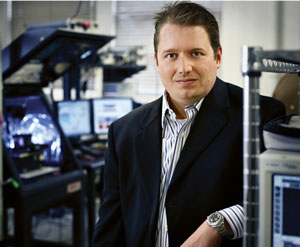| Mar 31, 2011 |
Microstructures innovation recognized as industry "game-changer"
|
|
(Nanowerk News) "Industry is eager to harness the potential of micro-technology, but has been unable to do so for most consumer products because of the high manufacturing cost," explained William P. King, a professor and Willett Faculty Scholar in the Department of Mechanical Science and Engineering."Our low-cost, scalable micro-manufacturing technology changes the game."
|
 |
| William P. King
|
|
"Microstructures molded onto a surface can change the properties of that surface," King added. "By molding microstructures into a surface, we can engineer the surface friction, heat transfer coefficient, or water repellency. All of these are in demand for energy applications, from hydraulic equipment to air conditioners to batteries."
|
|
King's innovation was recently selected by the Society of Manufacturing Engineers as one of the "2011 Innovations That Could Change the Way You Manufacture." This award is given to new and emerging technologies that are making a difference in manufacturing.
|
|
"This award recognizes our technology for micro-machining applied to consumer products," King said. "This technology is creating good manufacturing jobs today and tomorrow." The technology is being commercialized by Hoowaki LLC, a company co-founded by King in 2008. Hoowaki customers include many Fortune 100 companies.
|
|
According to King, micro-machining is used to fabricate complex microstructures onto the surface of metal molding tools, the metal templates used to form plastic, glass, or metal parts in a manufacturing process. The microstructures on the molding tools are transferred onto the final part during injection molding, embossing, or rolling. The presence of the microstructures on the final part changes the properties of the part.
|
|
"This is very high value-added technology," King remarked. "It dramatically changes the product that you are already buying today, resulting in improved performance and new properties. For example, one of the users of this technology is a company that is making implanted medical devices that run off of a battery. Because the battery implanted in your body, it must be small and carry as much energy as possible. By putting microstructures inside the battery, we can increase the battery surface area, which means more energy."
|
|
According to King, incorporating microstructures into a design can also reduce the amount of energy needed to run some machines.
|
|
"Increasing surface area changes the way that liquids interact with the surface, for example in the kinds of heat exchangers in your car or in an airplane. Similarly, you can heat or cool a home or building with much less energy."
|
|
More than improving a specific technology, King considers the technology as a "game changer," providing a significant opportunity for American industry.
|
|
"This is the way that manufacturing comes back to the U.S.," King added. "It's high-tech that we can lead. It adds a lot of 'know how' but at little cost, and it results in dramatically different performance for the things that you are buying today."
|
|
The fact that we can design these microstructure surfaces to give the performance of the surface we desire—engineering surface properties—to increase or decrease friction, water repellency, store energy.
|

